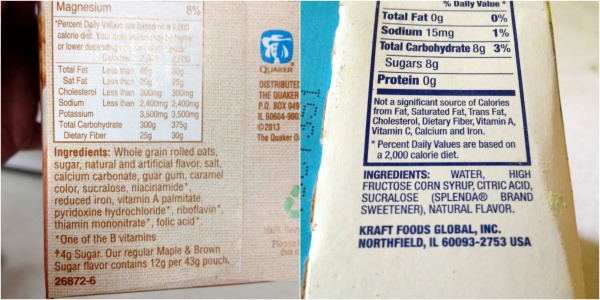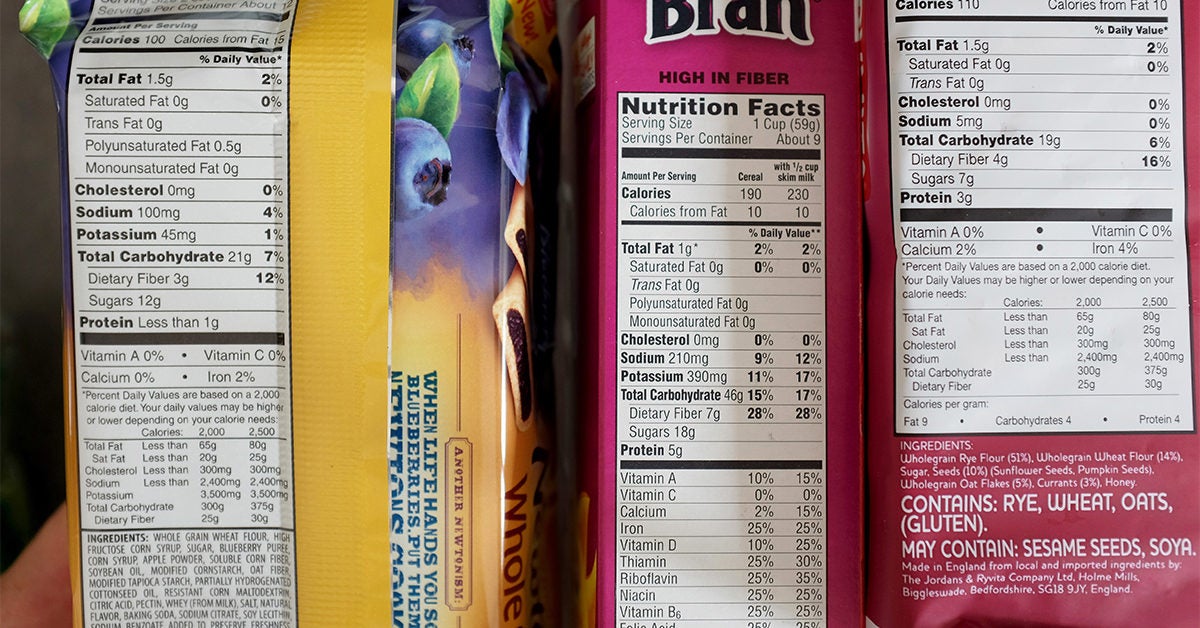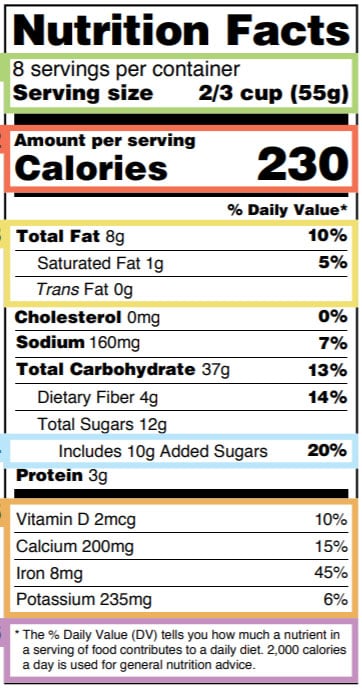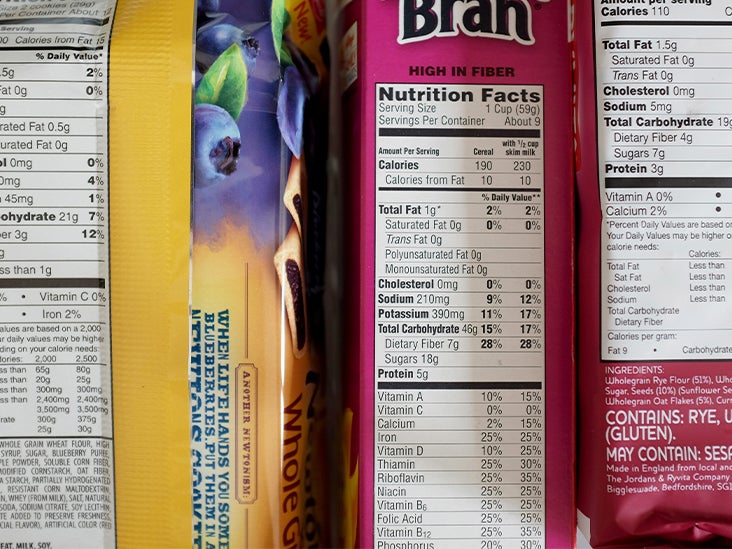43 reading sugar on food labels
How to understand food labels - Eat For Health Health claims are only permitted on foods that meet certain nutrition criterion, thereby preventing health claims on food higher in saturated fat, sugar or salt. Percentage Daily Intake Some labels also list nutrients in a serve of the product as a percentage of daily nutrient intake. Added Sugars on the New Nutrition Facts Label | FDA Labels for foods and beverages with added sugars will list the number of grams and the percent Daily Value (%DV) for added sugars within the Nutrition Facts label. Having the word "includes" before...
Reading food labels: Tips if you have diabetes - Augusta ... Reading food labels: Tips if you have diabetes. Content provided by Mayo Clinic. Date Updated: 06/25/2021. Start with the list of ingredients. Consider carbs in context. Put sugar-free products in their place. Beware of fat-free products. Know what counts as a free food. Do the math.

Reading sugar on food labels
Learning To Read Labels :: Diabetes Education Online On a nutrition food label, subtract the fiber from the total carbohydrate amount. When you read food labels, the grams of sugar are already included in the total carbohydrate amount, so you do not need to count this sugar amount separately. The grams of sugar listed include both natural sugars, from fruit or milk, and added sugars. How to Read a Food Label to Make Sure It's Keto in 3 Easy ... Step 1. Read the Ingredient List. Food manufacturers are required by the FDA to list ingredients in order of predominance by weight. The ingredient that weighs the most is listed first, and the ingredient that weighs the least is listed last. So stay away from foods where sugar or starch is listed as one of its first 5 ingredients. That's too ... How to Read Food Labels Without Being Tricked Other added sugars: barley malt, molasses, cane juice crystals, lactose, corn sweetener, crystalline fructose, dextran, malt powder, ethyl maltol, fructose, fruit juice concentrate, galactose,...
Reading sugar on food labels. Sugar: Food Sources, Health Implications, and Label-Reading Let's take a look at some labels to practice identifying naturally occurring and added sugars in foods. Below are labels from a 6-ounce serving of plain yogurt. There are 6 grams of total sugar and 0 grams of added sugar listed on the label. What ingredients contain naturally-occurring sugar? Figure 4.37. PDF Reading a Food Label - Joslin Diabetes Center Choose foods with at least 3 g of fiber per serving. 4. Subtract half of the Sugar Alcohol . Sugar alcohols, such as sorbitol, xylitol, maltitol and mannitol, are low-calorie sweeteners commonly used in sugar-free products. Because the carbohydrate in sugar alcohols is not fully absorbed, half of the sugar alcohol content can be How To Read Food and Beverage Labels | National Institute ... Be on the lookout for terms that indicate added sugar, such as brown sugar, corn sweetener, corn syrup, dextrose, fructose, and high-fructose corn syrup. Artificial sweeteners such as sucralose, saccharin, aspartame, and acesulfame should also be consumed in moderation. How to Read Nutrition Labels Reading nutrition labels can help you make informed food choices when you're shopping. Each label tells you what you're putting into your body and how much of each ingredient you are eating. This information is key to maintaining a healthy weight and keeping many health conditions in check, including diabetes, heart disease, and more.
How to read food labels | Health Advice Hub | Thrive from ... Sometimes, food labels only give the figure for sodium, and the figure is in mg instead of g. High is more than 1.5g salt per 100g and will be colour-coded red. Moderate is 0.3g-1.5g per 100g and will be colour-coded amber. Low is 0.3g salt or less per 100g and will be colour-coded green. Tip: Particular foods to look out for. How To Read Food labels for Sugar On the label check the sugars in the nutrition panel. 5g/ml or less of sugar per 100g/ml = this would count as low sugar content. It means 5% of the ingredients are sugar Between 5g/ml and 20g/ml of sugar per 100 grams = medium sugar content. With 20ml of sugar per 100 ml, this means the product is 20% sugar…not so good. Food label reading guide | Nutrition Australia Food Labels. Reading food and drink labels can help us make healthy choices. Food and drink labels will include information about the product, where and when it was made and a statement of ingredients, as well as any warnings or allergen statements. Reading Food Labels | ADA - American Diabetes Association The Nutrition Facts labels on foods are really the key to making the best choices. We'll cover the basics so that these labels make shopping easier for you. You've heard it all. From carb-free to low-carb, to whole and empty carbs, it's hard to know what it all means. Blood sugar highs and lows aren't always easy to understand.
PDF Label Reading the Healthy Way - Alberta Health Services Facts table to help you choose foods with less added sugar. Ingredient list: Read the ingredient list to know if a food has added sugar. Nutrition Facts table: On the Nutrition Facts table the Sugars includes both natural and added sugar. Compare brands and choose foods with a lower % DV for sugar. Limit foods with 15% or more DV for sugar. 13 Misleading Food Label Claims and How Not to Be Tricked While the term suggests that products labeled this way would be completely free of sugar, they can actually contain up to 0.5 grams of sugar in a single serving size. Products labeled sugar-free may also have higher levels of fat in order to make up for the taste and texture that is lost when sugar is removed. 2. Label Says "Fruit-Flavored" Reading food labels: Tips if you have diabetes - Mayo Clinic Look for foods with 3 or more grams of fiber. Put sugar-free products in their place Sugar-free doesn't mean carbohydrate-free. Sugar-free foods may play a role in your diabetes diet, but remember that it's equally important to consider carbohydrates as well. A sugar-free label means that one serving has less than 0.5 grams of sugar. Understanding food labels - Diabetes Ireland For example, the closer sugar is listed to the start of the ingredients, the more sugar the food contains. **Remember sugar can be described by many different names including sucrose, glucose, glucose syrup, fructose, glucose-fructose syrup, maltose, maltodextrin, invert sugar, golden syrup, maple syrup, molasses and honey.
PDF Reading food labels - Queensland Health Reading food labels . Understanding how to read food labels can help you make healthy food choices. Food Standards Australia and New Zealand (FSANZ) regulates food labelling in Australia. Most packaged food and drink must have a nutrition information panel. Exceptions include those in very small packages, some baked products and take-away food ...
PDF How to Read the Food Label Look for low- sodium foods with less than 140 mg per serving. Track the total amount you eat. Fiber. Aim for 25 to 38 grams of fiber per day. Sugars: Limit added sugars. Some vitamins and minerals may be listed with DV in one serving. Percent Daily Values (DV) tell you how much you should be eating based on a 2,000 or 2,500 calorie diet.
Food labelling - Making Sense of Sugar Sugars will be listed as carbohydrates (which usually include both starches and sugars) and will use the phrase “of which sugars” to show how much sugars there ...
How to Understand and Use the Nutrition Facts Label | FDA Added Sugars on the Nutrition Facts label include sugars that are added during the processing of foods (such as sucrose or dextrose), foods packaged as sweeteners (such as table sugar), sugars from...
Food Labels | CDC Check the Serving size first. All the numbers on this label are for a 2/3-cup serving. This package has 8 servings. If you eat the whole thing, you are eating 8 times the amount of calories, carbs, fat, etc., shown on the label. Total Carbohydrate shows you types of carbs in the food, including sugar and fiber.
Understanding sugar content on food labels - Diabetes Care ... Understanding sugar content on food labels is important, to ensure that you're consuming healthy amounts. Reading the ingredient lists and nutrition facts tables on packaged foods is a helpful way for you to check what kind, and how much, sugar a product has.
How to read labels for added sugar - That Sugar Movement Words such as 'sugar', 'syrup', 'juice', 'concentrate' or even 'crystals' one should be wary of. Words ending in '-ose' like glucose, fructose, dextrose or sucrose that are listed on a label are added sugars. Note: if they are naturally occurring, like glucose in whole fruit, it won't be listed as an ingredient.
How to read food labels - Safefood Some labels use colour coding to show at a glance if a food is high, medium or low in fat, saturated fat, sugar and salt. If the label isn't colour coded, use our label decoder as a guide. The fibre content is important when you are looking at foods such as bread, cereals, pasta and rice.






Post a Comment for "43 reading sugar on food labels"